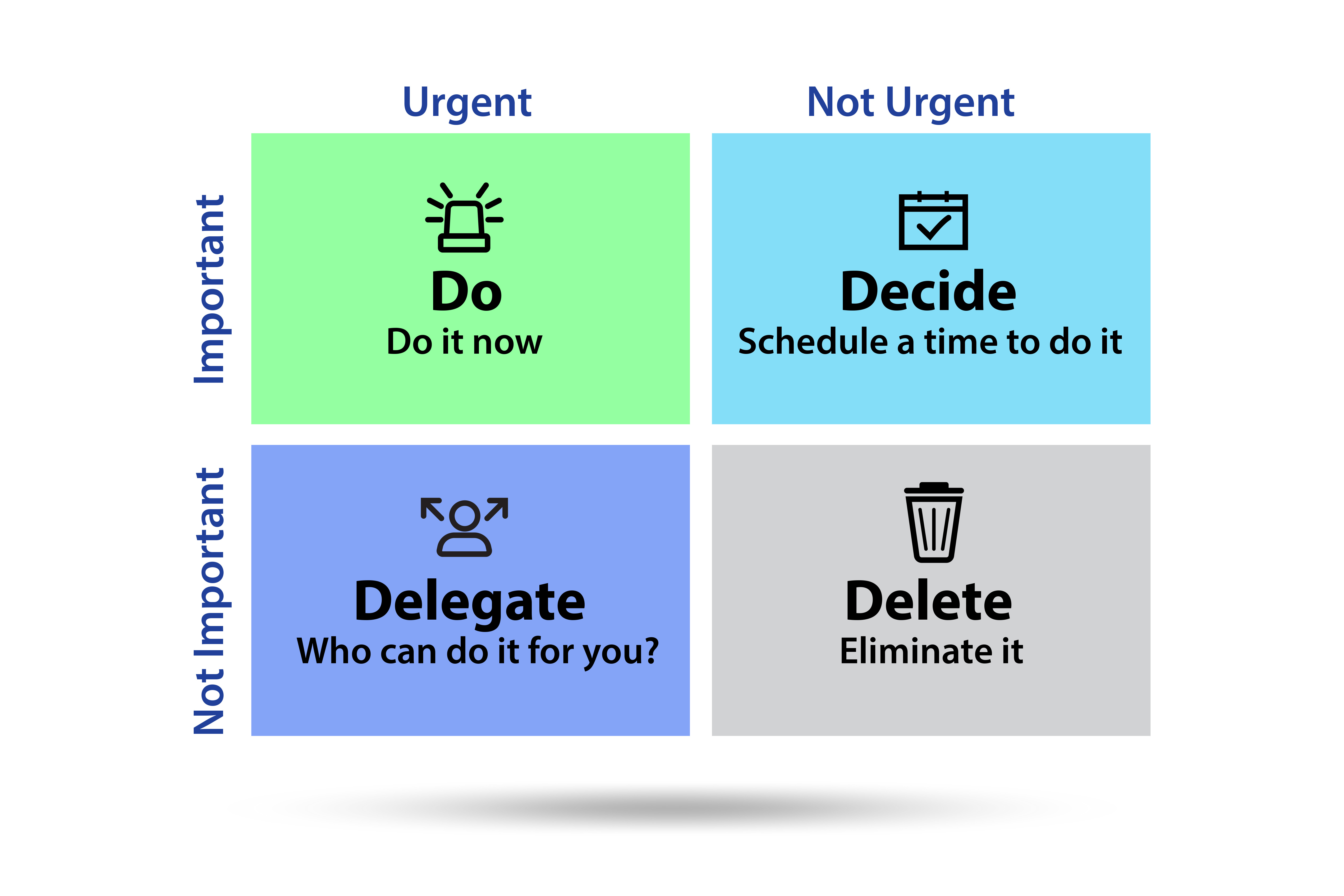Why the “Eisenhower matrix” is a fantastic productivity hack

- On a typical workday, it can feel like everything needs to be done immediately.
- The Eisenhower matrix helps us categorize the onslaught by organizing tasks by importance and urgency.
- If revisited regularly, the matrix can help us clarify our goals and values as well as how we should spend our most valuable resource — time.
Does this sound familiar? You have an important project due, but as soon as you log in for the day, your inbox pings relentlessly. You decide to sort the mess, but now you have a team meeting to attend. Before that meeting is even over, co-workers are messaging you for help putting out various fires, and your supervisor has planned an impromptu meeting to discuss a presentation due in a couple of months. By the time 5 p.m. rolls around, you’re nowhere near done with that important project, but now it has to compete with home responsibilities.
“On a typical workday, it can feel as if everything was due yesterday and everything needs to be done immediately. How do you make sense of what to do next when things can get so chaotic?” Gorick Ng, a career advisor at Harvard University, tells Big Think+. “It’s important to separate what is urgent from what is important.”
One tool to help you make that distinction is the “Eisenhower matrix.” Named after the 34th President of the United States, Dwight D. Eisenhower, aka Ike, the matrix helps us visualize which tasks demand our time and attention versus which can — and should — be deleted permanently from our to-do lists.

A matrix by any other name
Before we get to the technique itself, though, a bit of myth-busting. While the matrix takes its name from Eisenhower, there is no evidence that he invented, or even used, it. Rather, the naming seems to stem from conflating the technique’s focus on importance and urgency with a famous saying often attributed to Eisenhower. That saying is: “What is important is seldom urgent and what is urgent is seldom important.”
Did Eisenhower at least utter the quote, or is this a classic case of a pithy, yet common, saying being misattributed to a famous figure for gravitas? The answer is a little of both.
The former President did offer a version of the saying during a 1954 address at the Second Assembly of the World Council of Churches. His version: “I have two kinds of problems, the urgent and the important. The urgent are not important, and the important are never urgent.” However, he attributed the saying to a college president.
Even so, the lesson probably struck a chord with him. During the same address, he calls this “a dilemma of modern man,” and his prosperous career reveals an attentive person who contended with that dilemma head-on.
Before becoming President, Eisenhower served as the Supreme Allied Commander during World War II, successfully leading the invasion of Normandy in 1944. During his presidency, he ended the Korean War, tried to ease Cold War tensions, and spearheaded the interstate highway system. He even found the time to paint.
To keep his goals in focus among such varied and pressing demands, Eisenhower must have had some serious time-management skills. So even if he never used the matrix, he is still a worthy namesake.
The four Ds of time management
Setting up an Eisenhower matrix is simple enough. You draw a square and then divide it vertically and horizontally down the middle. This will give you four quadrants, separated into two rows and two columns. Label one column “urgent” and the other “not urgent.” Finally, label one row “important” and the other “not important.” That’s it.
You then fill your tasks into the appropriate columns. Except, of course, deciding what tasks go in which quadrant is where things get complicated. After all, what’s the cutoff between important and not important when everything feels like it needs to get done? And what’s the difference between urgent and not urgent when all those important tasks feel like they’re due now?
One strategy to help you decide is known as “the four Ds of time management.” The four Ds are do, decide, delegate, and delete, and each one corresponds to a quadrant on the Eisenhower matrix.

Here’s a breakdown:
Do (urgent and important). Ng says these tasks are at the core of your job. They are the things you were hired to do and have an upcoming deadline attached to them. Make these your most important tasks.
Decide (not urgent but important). These tasks are core to your job and goals, too, but their deadline is much further out. Decide if you have the time to advance them, but only after you’ve finished your more urgent tasks.
Delegate (urgent but not important). These tasks have a deadline but aren’t core to your job responsibilities. Paperwork and office surveys live and breed in this quadrant. If you can, delegate these tasks to someone else. If not, don’t spend a lot of time on them. And if you find yourself running out of time, move them to the delete quadrant when possible.
Delete (neither urgent nor important). Ng says it best, “[These] are the things to get rid of because they’re just crowding out your desk space, your drive space, your head space and causing you to not be able to focus on what really matters.” Delete, and don’t look back.
As a bonus, the Eisenhower matrix is adaptable. Not much of a matrix person? No problem. Write out a traditional to-do list using the four Ds as headers and fill in accordingly. Still find to-do lists helpful? Use the Eisenhower matrix to assign weekly tasks or even quarterly projects.
Working with, not around, the clock
A complementary strategy is offered by James Clear, author of Atomic Habits. He recommends a form of self-interrogation. Before placing any task in the matrix, ask yourself: What are you working toward, and what are the core values driving your life?
That may seem existentially excessive for determining whether or not to tidy your inbox, but these questions help to clarify which tasks vying for your time are truly important.
For instance, certain attentional biases make it easy for us to confuse urgency with importance. Emails, texts, phone calls, news stories, and social media updates grab our attention with a perfectly pitched ding. This causes us to overemphasize their importance, priming us to attend to the distraction immediately. To make the challenge even more difficult, an important email or social media post gives off the same urgent notification as an unimportant one.
The Eisenhower matrix can help you better determine which emails, texts, social media posts, etc., among the swarm need to be followed up now and which can wait. This way you can sidestep the ubiquitous call of the urgent.
Slowing down to clarify your values and goals can also help you reassess how you’re spending your most precious resource — time. After all, lifetime goals are achieved based on how we spend our individual days, so important tasks aren’t just the ones vying for our attention today. They’re the ones that drive us toward where we want to be tomorrow.
All the while, the clock is ticking away in the background. If a clean inbox isn’t driving you toward those goals, it can wait.
“Deciding which tasks to do and which tasks to delete becomes much easier when you are clear about what is important to you,” Clear writes, adding, “The Eisenhower matrix isn’t a perfect strategy, but I have found it to be a useful decision-making tool for increasing my productivity and eliminating the behaviors that take up mental energy, waste time, and rarely move me toward my goals.”

Be like Ike
How will you know when your priorities are in proper order? If the matrix is working as it should, says Ng, three things will be true in your work and life. They are:
- You are doing what you say you will do.
- You aren’t surprising anyone with late submissions or last-minute changes of plans.
- You’re sane and happy.
As wonderful as those are, though, they won’t last forever. Over time, we’ll all start to see the late submissions pile up again and feel our sanity begin to slip away. It’s only natural and, ultimately, beneficial. When not ongoing or overly intense, feelings such as anxiety, boredom, and restlessness are our body’s way of informing us that something is off. It’s time for a change.
For this reason, it’s best to revisit the Eisenhower matrix from time to time. Some people will find it handy for creating daily or weekly to-do lists. Others will use it during yearly or quarterly reviews. Still others only in times when they need to reaffirm that their values and efforts are lining up.
Whatever your preferred cadence, remember that time management is a moving target. The things that are important to us can and do change. Eisenhower himself had very different goals and responsibilities at different times in his career. The point isn’t to dedicate yourself to optimizing every day to timekeeper perfection. It’s to ensure that you don’t lose sight of your values and goals amid the chaos.
As Ng tells us: “This is all possible if you are methodical about what tasks you take on, which tasks you do right now, and which tasks to maybe shed from your life.”






